After the Great Hanshin-Awaji Earthquake took place, fires broke out burning down close to 7,000 houses and buildings in Nagata Ward, Kobe City. Mrs. Ishikura said that she was at home, looking toward Shin-Nagata Station and felt sure that Yamakichi Market located on the north side of the station was also on fire. It was the place where Mrs. Ishikura had opened her Kurara Bakery only nine months before.
The bakery, however, miraculously survived the fire. While baking bread at the half destroyed bakery, Mrs. Ishikura was talking about a dream like so.
“How I wish that Tora-san, the hero of my favorite movie, ‘Otoko wa Tsurai yo,’ would visit here as a volunteer to help us to sell bread at discount prices, and then fall in love with me…”
Mrs. Ishikura at that time never imagined that her dream could come true with “Otoko wa Tsurai yo: Torajiro Kurenai no hana” (released in December 1995, starring Kiyoshi Atsumi, and originally written and directed by Yoji Yamada)
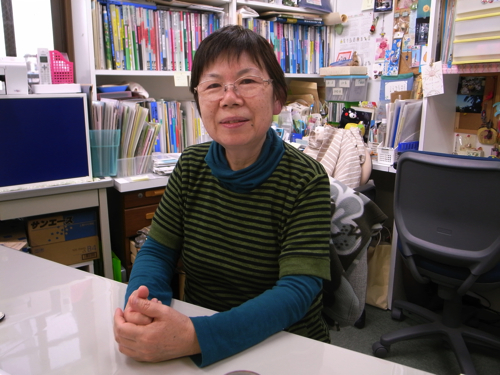 A dream of living with people with disabilities in the local community
A dream of living with people with disabilities in the local community
Mrs. Ishikura began to support people with disabilities at the age of 20. As her sister is mentally challenged, she joined activities in Kobe Kyodai Kai where people who have brothers or sisters with disabilities get together. Then, starting with Kurara Bakery, Mrs. Ishikura and her husband Taizou set up a community workshop, a group home, and Nonprofit Organization Network Nagata. These facilities were established to allow people with disabilities to live in the local community. Mr. and Mrs. Ishikura have been operating them ever since.
Nonprofit Organization Network Nagata now has ten full-time employees including three part-time workers. The number of people who use the community workshop has grown from 5 when it was started 20 years ago, to between 35 and 40.
“About 35 years ago, people with disabilities had no choice but to move to institutions located far from home when they lost their parents. A group home or a workshop allows such people to live in the local community. That was our dream.”
In 1991, Mrs. Ishikura and people from Kobe Kyodai Kai opened Group Home Taro, the first group home in Kobe with Social Welfare Corporation Enpitsu No Ie as its parent organization, followed by Group Home Ehon (present-day Communal Living Office Home Ehon) in 2001. Then, she had even a bigger dream and hoped that one day she would build a building which accommodated her home, the workshop, and the group home.
She said, “My dream has become a reality to a large degree because Kurara Bakery, Home Ehon and our own home are standing side by side.”
Having said that, a series of major accidents happened to Mrs. Ishikura before then. One of them was the Great Hanshin-Awaji Earthquake, which occurred on January 17, 1995.
The quake was terrifying but I remember being helped by so many people.
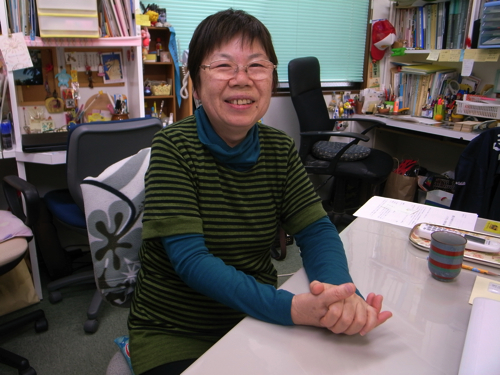
On the morning of the earthquake, Mrs. Ishikura was getting lunch prepared for her second daughter who was about to go to her school club practice. Surprised by the powerful quake, Mrs. Ishikura ran in to hug her second daughter with a frying pan still in her hand.
“I wanted to turn off the gas but I was paralyzed. When the quake calmed down a little, I rushed to my eldest daughter and found a big TV fallen close to her head. For some reason, she had repositioned herself from the place where she usually sleeps, which saved her life.”
Her eldest daughter, Ai, has been seriously disabled since birth, so Mrs. Ishikura had always cared for her. However, since the earthquake really upset Mrs. Ishikura, she could not even think if her eldest daughter was OK.
Although damaged, Mrs. Ishikura’s new home had survived. So her relatives and other evacuees, a total of 15 people, temporarily lived together at her place and the group home. On February 1, two weeks after the earthquake, Mr. and Mrs. Ishikura, and people at Enpitsu No Ie set up a center for people with disabilities at the disaster site. They started to receive registration of disaster-relief volunteers from across the country and to dispatch them.
“People from less affected areas including some from Kobe Kyodai Kai and my neighbors brought us vegetables and rice. The earthquake was terrifying but I remember being helped by so many people.”
Workshops had been alienated from each other, but the earthquake brought them together, and people in the workshop also started to contact people in Yamakichi Market where Kurara Bakery was located.
“Yamakichi Market was old and started before the war. Store owners in the market seemed to wonder why disabled people were working. After the earthquake, we used donations and supplies to provide meals outdoors in front of the market, and bought food from people in the market and asked for their cooperation. It was then that people in the market saw us in a different light.”
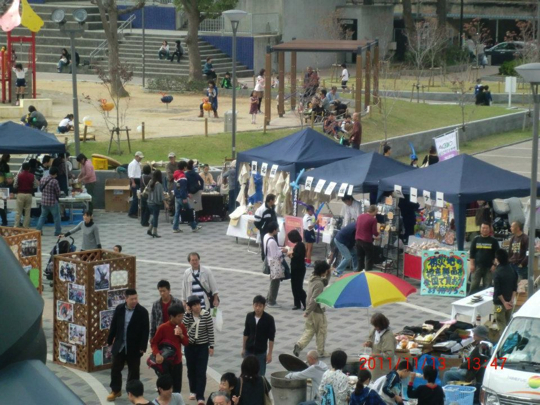 Photo: Extended Ichi Nana Market held in November 2011
Photo: Extended Ichi Nana Market held in November 2011
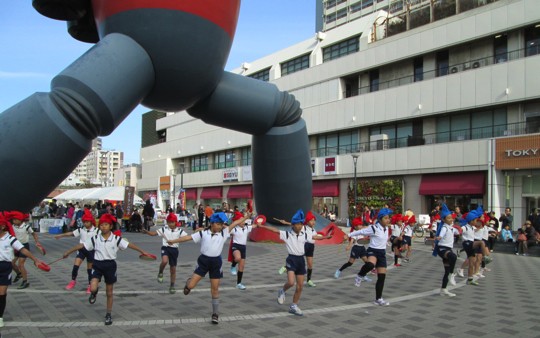 Photo: Extended Ichi Nana Market held in November 2014, two decades after the earthquake. Elementary school children are dancing the Eisa dance!
Photo: Extended Ichi Nana Market held in November 2014, two decades after the earthquake. Elementary school children are dancing the Eisa dance!
Since Mrs. Ishikura started a bazaar, the Ichi Nana Market in November 1995, people in the market have actively cooperated with her. One year later, she held the Extended Ichi Nana Market which more workshops participated in. The market has now grown, with about 40 organizations including companies, Nagata Volunteer Center, and elementary school and junior high school students now taking part.
After the Ichi Nana Market, the workshop set up a section to develop new products. An event called the Kodomo Ichiba Market was also created so that people from Nagata Central Market, the local shopping area, and elementary school children could experience the workshop together and sell what they made there at the event.
A letter inviting Tora-san, her dream man
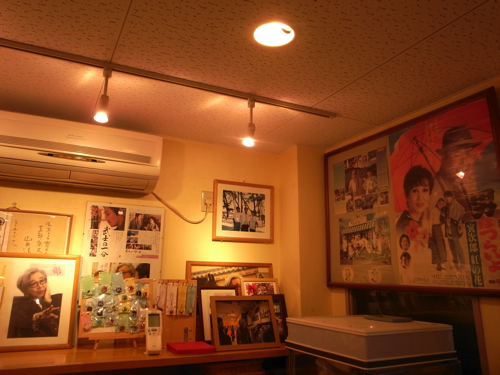 Photo: A section for “Torajiro Kurenai no hana” in Kurara Bakery
Photo: A section for “Torajiro Kurenai no hana” in Kurara Bakery
In the spring of that year, a group was set up in Kobe to attract Tora-san, the filmmaker of the movie Otoko wa Tsurai yo, to shoot a movie in Kobe, and collected 35,000 signatures. When Mrs. Ishikura leaned about this, she decided to write a letter to the director of the movie, Yoji Yamada.
“I received an autographed card from Mr. Yamada four or five days after I sent the letter. He wrote, ‘It must have been hard for you. I will keep Kurara Bakery in my mind.’ I didn’t expect him to write back to me, so, it was surprising.”
On the day before the shooting of the movie, Otoko wa Tsurai yo: Torajiro Kurenai no hana, in Kobe, Mrs. Ishikura was even more surprised to get a call from a newspaper reporter from the Kobe Shimbun saying that “The name of the bakery in the movie is Ishikura Bakery!”
“I was invited to a preview of the movie. I was thrilled hearing Mr. Daisuke Miyagawa saying when he visited Toraya in Shibamata in the movie that, ‘I am Ishikura, baking bread in Nagata.’ I was also touched to see the sign on the bakery and myself as an extra in the movie. The film is very precious to us.”
The sign, “Ishikura Bakery”, used in the movie is displayed inside Kurara Bakery. The current sign on her bakery was made in the style of the one shown in the movie.
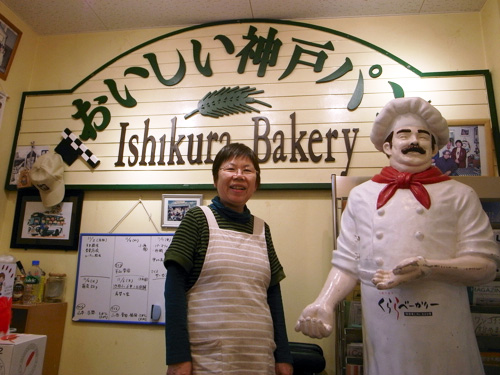 Photo: The sign used in the movie displayed inside Kurara Bakery
Photo: The sign used in the movie displayed inside Kurara Bakery
“The movie also reminds us of the disaster. I think Tora-san and people in Nagata have been strongly connected since Tora-san came here.”
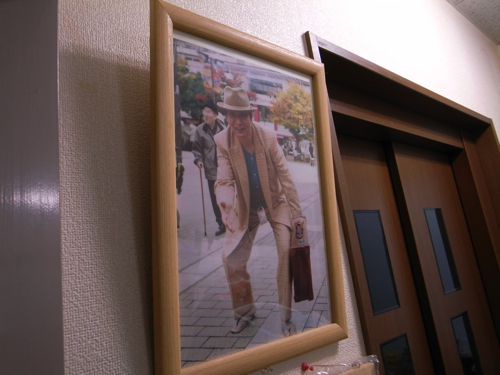 Photo: Nagata version of Tora-san. He looks just like the real Tora-san!
Photo: Nagata version of Tora-san. He looks just like the real Tora-san!
When events are held for people who visit the location of the movie, Mr. Taizou Ishikura plays the role of Tora-san wearing a felt hat, a suit, a belly band, and Japanese sandals. Mrs. Ishikura said that her husband was usually shy, but when wearing those, he beautifully showed off a street vender’s sales pitch by exactly mimicking Tora-san.
Support for the bakery of Tora-san when in trouble
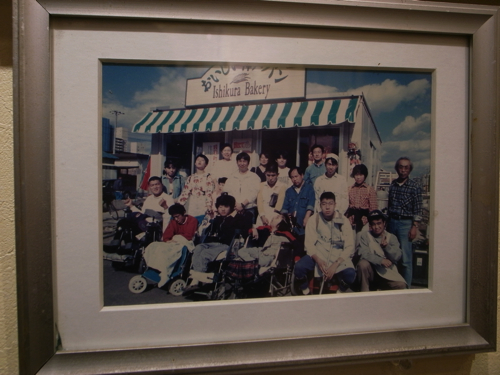 Photo: With people from Kurara Bakery in front of the movie set of Torajiro Kurenai no hana
Photo: With people from Kurara Bakery in front of the movie set of Torajiro Kurenai no hana
It was not long before Kurara Bakery was asked to relocate to another place due to a land adjustment project. However, the site proposed for their relocation was opposed by nearby residents. Therefore, Kurara Bakery found another location advertised in a newspaper, but again the price of the land was higher than thier budget, even including the disaster recovery fund.
Newspapers then reported about the problem Tora-san’s Bakery was facing. People from across the country sent donationsamounting to 20 million yen, which enabled the shop to reopen at the new site.
Nevertheless, Kurara Bakery had a third misfortune in 2004 when it was just getting under way. A suspicious fire broke out at the bakery.
“When the accident was reported on the 9 o’clock news in the evening, about 100 people visited us until 12 midnight. A person from Sun Television said, ‘No one was hurt, and the fire did not spread next door. Many people came to see you. Luckily, people across the street fought the fire at an early stage while you were away.’ I was comforted by the words.”
“If it had not been for the earthquake, we would not have been able to respond like that,” Mrs. Ishikura recalled. “The next day, people from Nagata Volunteer Center set up ‘disaster response headquarters,’ and people from the workshop and the ward office helped us to clean up the damage.”
I would like to create a community in which people with disabilities can participate.
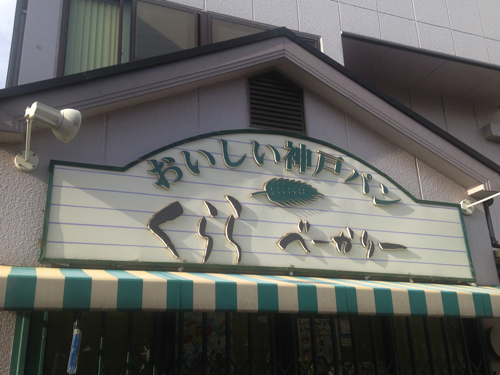 Photo: The sign of the bakery made in the style of the one used in the movie
Photo: The sign of the bakery made in the style of the one used in the movie
Kurara Bakery is open to anyone who wants to experience baking bread or to join volunteer activities. It has accepted people from nursery schools, elementary schools, and homes for senior citizens, people with disabilities, and new company employees who take training programs. This concept is based on the belief of Mrs. Ishikura and people from the bakery that Kurara bakery would not have started if it were not for the support of many people.
In addition, Mrs. Ishikura hopes that people will learn more about the disabled.
“I hope that more companies will have a broad mindset towards employment of people with disabilities. It should not only be the idea of how companies can use the disabled to be profitable, but that people with disabilities should do what they can do better, or it is significant for such people to be there because they can participate in society.”
“I believe that a place good to live in for people with disabilities and seniors will serve as a good place for everyone from a mental perspective and a facility perspective.”
Mrs. Ishikura says, “Everyone wants to do something that is appreciated by others.” Through the experience of baking bread together and exchanging words such as, “It is delicious,” and “Thank you,” people will change their way of looking at how the place they live in should be.
(Interviewed and written by Kyoko Sugimoto)
This article was created with the cooperation of
greenz.jp.
![]() a baker
a baker JP | EN
JP | EN JP | EN
JP | EN

 Photo: Extended Ichi Nana Market held in November 2011
Photo: Extended Ichi Nana Market held in November 2011 Photo: Extended Ichi Nana Market held in November 2014, two decades after the earthquake. Elementary school children are dancing the Eisa dance!
Photo: Extended Ichi Nana Market held in November 2014, two decades after the earthquake. Elementary school children are dancing the Eisa dance! Photo: A section for “Torajiro Kurenai no hana” in Kurara Bakery
Photo: A section for “Torajiro Kurenai no hana” in Kurara Bakery Photo: The sign used in the movie displayed inside Kurara Bakery
Photo: The sign used in the movie displayed inside Kurara Bakery Photo: Nagata version of Tora-san. He looks just like the real Tora-san!
Photo: Nagata version of Tora-san. He looks just like the real Tora-san! Photo: With people from Kurara Bakery in front of the movie set of Torajiro Kurenai no hana
Photo: With people from Kurara Bakery in front of the movie set of Torajiro Kurenai no hana Photo: The sign of the bakery made in the style of the one used in the movie
Photo: The sign of the bakery made in the style of the one used in the movie